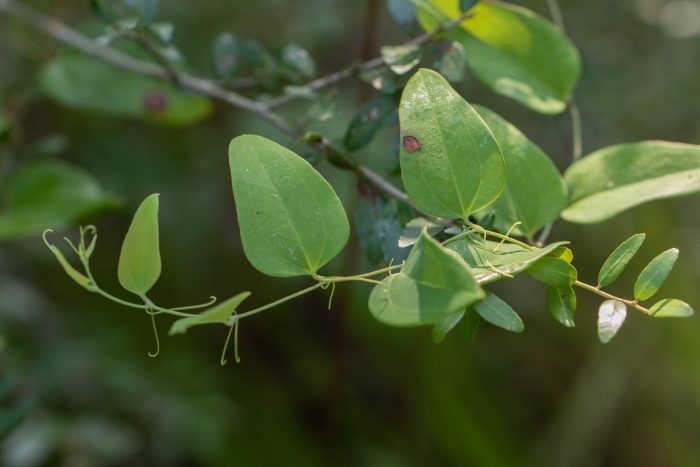Cat Greenbriar
(Smilax glauca)
Cat Greenbriar (Smilax glauca)
/
/

kirk gardner
CC BY 4.0
Image By:
kirk gardner
Recorded By:
Copyright:
CC BY 4.0
Copyright Notice:
Photo by: kirk gardner | License Type: CC BY 4.0 | License URL: http://creativecommons.org/licenses/by/4.0/ | Rights Holder: kirk gardner | Publisher: iNaturalist | Date Created: 2019-08-30T09:26:42-07:00 |

























Estimated Native Range
Summary
Smilax glauca, commonly known as Cat Greenbriar or Saw Greenbrier, is a perennial woody vine native to a variety of habitats including deciduous forests, thickets, and wetland margins in the central and eastern United States, as well as Mexico. It typically climbs using tendrils and can reach substantial heights when supported by trees or structures. The plant features gray-glaucous leaves that are often heart-shaped and can provide dense coverage. Smilax glauca produces small, inconspicuous greenish flowers in the spring, followed by clusters of fleshy, dark blue to black berries that are attractive to wildlife.
Cat Greenbriar is valued for its ability to form dense thickets that provide shelter and food for birds and other wildlife. It is also used for its ornamental foliage in naturalistic plantings and as a screening plant. In cultivation, it prefers partial shade to full sun, moist to average well-drained soils, and is tolerant of a range of soil types, including sandy and clay soils. It is relatively low-maintenance once established but may require pruning to control its spread. While it is not typically troubled by serious pests or diseases, it can become aggressive and may need management to prevent it from overtaking other plants.CC BY-SA 4.0
Cat Greenbriar is valued for its ability to form dense thickets that provide shelter and food for birds and other wildlife. It is also used for its ornamental foliage in naturalistic plantings and as a screening plant. In cultivation, it prefers partial shade to full sun, moist to average well-drained soils, and is tolerant of a range of soil types, including sandy and clay soils. It is relatively low-maintenance once established but may require pruning to control its spread. While it is not typically troubled by serious pests or diseases, it can become aggressive and may need management to prevent it from overtaking other plants.CC BY-SA 4.0
Plant Description
- Plant Type: Shrub, Vine
- Height: 4.9-10 feet
- Width: 3-6 feet
- Growth Rate: Rapid
- Flower Color: Green, White
- Flowering Season: Spring, Summer
- Leaf Retention: Evergreen
Growth Requirements
- Sun: Full Sun, Part Shade
- Water: Medium
- Drainage: Fast, Medium, Slow
Common Uses
Bird Garden, Deer Resistant
Natural Habitat
Deciduous forests, thickets, and wetland margins
Other Names
Common Names: Glaucous Greenbrier, Catbrier, Sawbrier, Wild Sarsaparilla
Scientific Names: , Smilax glauca, Smilax caroliniana, Smilax discolor, Smilax glauca var. discolor, Smilax glauca var. genuina, Smilax glauca var. glauca, Smilax glauca var. leurophylla, Smilax sarsaparilla, Smilax spinulosa,
GBIF Accepted Name: